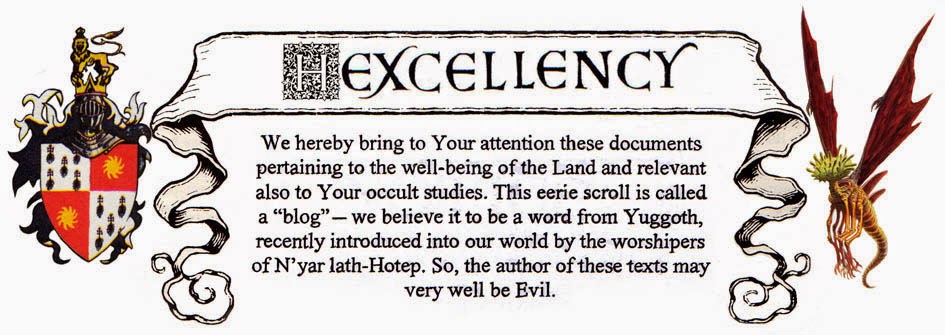I now realize how much Gen Con got it right
back in ’74 (literally from the start) with Tournament Play, and participants
who often didn’t know each other. Because, let’s face it: time wasted is one of
the main afflictions – if not the main affliction – in tabletop RPGs;
and why, I ask, do players waste time? Two reasons:
Reason #1. Players waste time because they’re
in no hurry. If they don’t get to the evil sorcerer’s lair tonight, they’ll
get there next month, or in three months, when they play their next game
session. There is no deadline: why rush in? Tournament play solves that
completely. “Here’s the situation. This is happening, and these goblins over
there are digging something up in the crevasse, and that warlock begun his
ritual to summon up something nasty... You guys have six hours. It starts now.
What do you want to do?”
Reason #2. Players waste time because they
all know each other. They’ve all been friends since ’84 or so. They are glad to
see each other. They’re fired up. They brought wine. They’re thirsty. They
start talking about Windows 8. Then they talk about Cuba and going south in January.
Then someone says the word “Linux”, and that’s another hour vanishing...
Tournament play solves that, too. The players sit down, introduce themselves,
let the DM have a look at their character record sheets, and start gaming
almost immediately.
It’s still very cool to play with your old
gaming buddies, though. Sometimes I’ll put someone new in the lineup – one of
my cousins, or a coworker – but at its core, it stays mostly my old friends. I
couldn’t really solve that time wasting aspect of the game, so I’ve
decided to definitely solve the other: I now give each scenario a time limit. Forget
long mods like Tsojcanth. Now it’s mini-games, playable in under 8
hours. A beginning, a middle, and an end – all in the same game session. If it’s
a dungeon crawl, there’s gonna be less than 10 rooms to explore, and only
between 3 and 5 fight scenes. Still, if they don’t have enough time to “finish”
the dungeon, that’s that, and it’s just too bad.
November 29, I ran my second game of
AD&D in 28 years. I talked about the first session in a previous post, and
the results were dismal. Now, there’s improvement. But there is room for further
improvement – as always.
After years and years of multisession
adventures, it’s hard to pick up the pace. We were accustomed to extensive
analysis and brainstorming; we even invented a new word for it: metagaming.
This is when players are out of character, discussing the difficulties /
challenges / technical aspects of a particular scenario. It’s annoying
sometimes, because real medieval warriors wouldn’t think that much, but that’s
the world we live in: what can you expect when every one of your friends is a
network programmer or a teacher? If you hate the OOC shit, just get yourself a
bunch of actor friends – theater majors, that kind of people. They will really
play the Elf or the wizard or the monk. Meanwhile, work with what you have, and
what you have is metagaming, which we also called tobyism, because of Tobias
who really did it a lot.
But now that I want to switch us back to
good old tournament play – i.e. with a time limit –, the guys need to
reacquaint themselves with the forgotten arts of “winging it” and “going in
blind” and other brands of instant decision-making. I was asking myself: why do
I always cringe, and not them? Because they don’t know the rooms still
left to explore, but I do. It gave me an idea...
What about if I handed the players a
complete map of the dungeon right at the beginning, with all the rooms, but no clues
regarding monsters or traps? They’d have a visual reference as the game progresses,
and they’d be able to see all that’s still unexplored.
Like I wrote four months ago, it’s a
question of identifying the “profitable” part of any sandbox-ish scenario.
Where is the good stuff stashed away? In this case, the good stuff waited in
three pocket dimensions accessible through a magical stone slab in the mansion’s
basement. But THEY DIDN’T GO of course – except for the bard who entered one of these dimensions alone, but am I gonna bust the lich and his five mummies just for
one PC? (Huge exaggeration here about the monsters, but you got my whiff.)
Tournament is definitely the way, but I
think there ought to be some visual aid for the players – a sort of “Dungeon
Completion Chart”. Nine main rooms, plus a number of corridors and stairwells
and possibly traps. We’re already two hours in, and we only cleared two main
rooms out of nine. We’re behind schedule, guys!
I’m sure there is some way to integrate this
in the story.
Tournament is not logical. “Why do we
only have six hours to do this?” Well, why not? Dungeon crawls aren’t logical
anyway. You go on myth-weavers.com and click “generate dungeon”, but what is
this damned dungeon exactly? Who built it, and why? Wanting to go logical in D&D
is a slippery slope indeed. Like I used to say: everybody killed Drelnza, and
then met in a tavern to swap stories about how they killed her...
Please check your logic at the door.
If at least one of your friends is an adept
of vaping, and if he brought his e-cigarette (you know he did), then you have
access to amazing special effects during your combat scenes, like in this
photo: mansion’s on fire and they’re all fighting the evil intruders in a thick
cloud of smoke!



